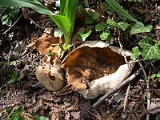
Disciotis
Encyclopedia
Disciotis is a genus
of fungi in the family
Morchellaceae
. Members of this family, characterized by their cup- or bowl-shaped apothecia, have a widespread distribution, especially in northern temperate
regions.
with vein-like hymenial
folds and a small to non-existent stipe
.
is Disciotis venosa, originally described as Peziza venosa by Christian Hendrik Persoon
in 1801. Other species described in the genus include:
It has been suggested that these species (and variants not listed above) all represent a single, morphologically
variable species.
Genus
In biology, a genus is a low-level taxonomic rank used in the biological classification of living and fossil organisms, which is an example of definition by genus and differentia...
of fungi in the family
Family (biology)
In biological classification, family is* a taxonomic rank. Other well-known ranks are life, domain, kingdom, phylum, class, order, genus, and species, with family fitting between order and genus. As for the other well-known ranks, there is the option of an immediately lower rank, indicated by the...
Morchellaceae
Morchellaceae
The Morchellaceae are a family of ascomycete fungi. According to a standard reference work, the family contains 49 species distributed among 4 genera...
. Members of this family, characterized by their cup- or bowl-shaped apothecia, have a widespread distribution, especially in northern temperate
Temperate
In geography, temperate or tepid latitudes of the globe lie between the tropics and the polar circles. The changes in these regions between summer and winter are generally relatively moderate, rather than extreme hot or cold...
regions.
Description
Disciotis has a cupulate (cup-shaped) pileusPileus (mycology)
The pileus is the technical name for the cap, or cap-like part, of a basidiocarp or ascocarp that supports a spore-bearing surface, the hymenium. The hymenium may consist of lamellae, tubes, or teeth, on the underside of the pileus...
with vein-like hymenial
Hymenium
The hymenium is the tissue layer on the hymenophore of a fungal fruiting body where the cells develop into basidia or asci, which produce spores. In some species all of the cells of the hymenium develop into basidia or asci, while in others some cells develop into sterile cells called cystidia or...
folds and a small to non-existent stipe
Stipe (mycology)
thumb|150px|right|Diagram of a [[basidiomycete]] stipe with an [[annulus |annulus]] and [[volva |volva]]In mycology a stipe refers to the stem or stalk-like feature supporting the cap of a mushroom. Like all tissues of the mushroom other than the hymenium, the stipe is composed of sterile hyphal...
.
Species
The type speciesType species
In biological nomenclature, a type species is both a concept and a practical system which is used in the classification and nomenclature of animals and plants. The value of a "type species" lies in the fact that it makes clear what is meant by a particular genus name. A type species is the species...
is Disciotis venosa, originally described as Peziza venosa by Christian Hendrik Persoon
Christian Hendrik Persoon
Christiaan Hendrik Persoon was a mycologist who made additions to Linnaeus' mushroom taxonomy.-Early life:...
in 1801. Other species described in the genus include:
- Disciotis ferruginascens Boud.
- Disciotis maturescens Boud. (1891)
- Disciotis rufescens R. Heim (1934)
It has been suggested that these species (and variants not listed above) all represent a single, morphologically
Morphology (biology)
In biology, morphology is a branch of bioscience dealing with the study of the form and structure of organisms and their specific structural features....
variable species.
External links
- Disciotis at Index FungorumIndex FungorumIndex Fungorum, an international project to index all formal names in the Fungi Kingdom. Somewhat comparable to the IPNI, but with more contributing institutions....

